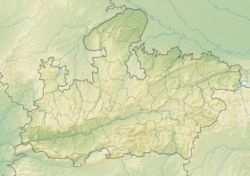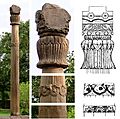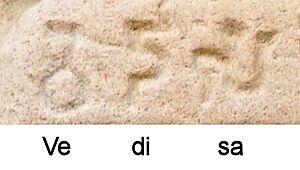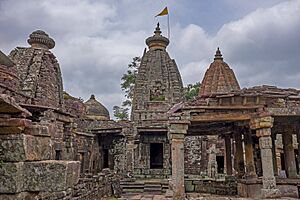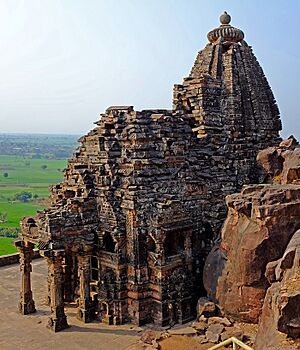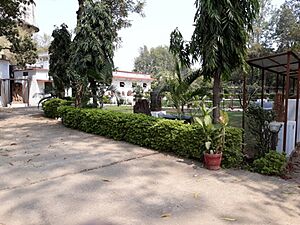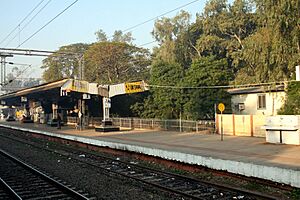Vidisha facts for kids
Quick facts for kids
Vidisha
विदिशा
|
|
|---|---|
|
City
|
|
|
Heliodorus pillar
Ancient Sculpture of Varahavtar
|
|
| Country | |
| State | Madhya Pradesh |
| District | Vidisha |
| Elevation | 424 m (1,391 ft) |
| Population
(2011)
|
|
| • Total | 155,959 |
| Languages | |
| • Official | Hindi |
| Vehicle registration | MP-40 |
Vidisha (विदिशा) is a historic city in central Madhya Pradesh, India. It was once known as Bhelsa and, long ago, as Besnagar and Bhaddilpur. The city is about 62.5 kilometers northeast of Bhopal, the state capital. Its name, "Vidisha," comes from the nearby "Bais" river, which is mentioned in ancient texts called the Puranas.
The area around Vidisha became a district in 1904. It was first called Bhilsa District. After India became independent in 1947, this area became part of the new state of Madhya Bharat. The city was officially renamed Vidisha in 1956. Today, Vidisha is also part of a special program by the Indian government to help develop certain districts.
Contents
People of Vidisha
As of 2011, about 155,959 people lived in Vidisha. Slightly more than half of the people (53.21%) are male, and 46.79% are female. Most people in Vidisha can read and write, with a literacy rate of 86.88%. This is higher than the average for all of India. About 15% of the people in Vidisha are under six years old.
A Look Back in Time: Vidisha's History
Ancient Besnagar
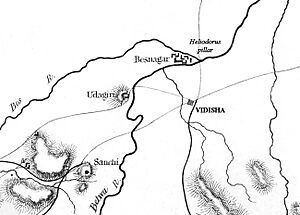
Vidisha is located east of the Betwa River, where it meets the Bes River. It is also close to the famous Sanchi stupas. Long ago, about 2,500 years ago, a town called Besnagar was a very important trading center. It was ruled by powerful empires like the Shungas and Guptas. Ancient texts also mention Besnagar.
Even Emperor Ashoka was once the governor of Vidisha. His first wife, Empress Vidisha Devi, grew up here. The famous poet Kalidasa also wrote about Vidisha in his work Meghaduta.
In the 1870s, an archaeologist named Alexander Cunningham explored the ruins of Besnagar. He found parts of a large protective wall and old Buddhist railings. Many ancient coins were also discovered, including some from the Western Satraps.
The Heliodorus Pillar
The Heliodorus Pillar is a very old stone column built around 150 BCE. It was put up by a Greek ambassador named Heliodorus. He came from the kingdom of Antialcidas to visit King Bhagabhadra. This pillar is dedicated to Lord Vāsudeva, who is now seen as a form of Lord Vishnu.
The pillar is about four kilometers from Vidisha, near the Vais River. It stands 20 feet and 7 inches tall and is often called Kham Baba. An inscription on the pillar, written in the Brahmi script, says that Heliodorus built it to honor Lord Vasudeva.
Vidisha Becomes Bhelsa
Besnagar later became known as Bhelsa during the Middle Ages. It was famous for a temple dedicated to the Sun god, Bhillasvamin. Kings from the Later Gupta dynasty and Rashtrakutas ruled here. An old inscription from 878 CE first mentions the name Bhelsa.
Sadly, the temple was destroyed in 1233–34 CE. Later, in 1293, Alauddin Khalji attacked and looted the city. This shows how important Vidisha was during that time. In 1532, Bahadur Shah of Gujarat also attacked Bhelsa. Over time, the city was ruled by different groups, including the Mughals.
Jainism in Vidisha
Vidisha is a very important place for followers of Jainism. It is believed to be the birthplace of Shitalanatha, who was the tenth tirthankar (a great teacher) in Jainism.
There are 14 Jain temples in Vidisha. Some of the most famous ones, built between the 9th and 10th centuries CE, include Bada Mandir, Bajramath Jain temple, Maladevi temple, Gadarmal temple, and Pathari Jain temple. These temples are known for their beautiful architecture.
Weather in Vidisha
| Climate data for Vidisha (1981–2010, extremes 1970–2003) | |||||||||||||
|---|---|---|---|---|---|---|---|---|---|---|---|---|---|
| Month | Jan | Feb | Mar | Apr | May | Jun | Jul | Aug | Sep | Oct | Nov | Dec | Year |
| Record high °C (°F) | 35.0 (95.0) |
36.2 (97.2) |
42.1 (107.8) |
46.9 (116.4) |
49.1 (120.4) |
49.0 (120.2) |
43.3 (109.9) |
38.6 (101.5) |
39.0 (102.2) |
40.8 (105.4) |
38.0 (100.4) |
35.0 (95.0) |
49.1 (120.4) |
| Mean daily maximum °C (°F) | 26.2 (79.2) |
29.5 (85.1) |
34.7 (94.5) |
40.2 (104.4) |
42.8 (109.0) |
38.9 (102.0) |
32.3 (90.1) |
30.3 (86.5) |
32.2 (90.0) |
34.0 (93.2) |
31.4 (88.5) |
27.9 (82.2) |
33.4 (92.1) |
| Mean daily minimum °C (°F) | 8.3 (46.9) |
10.8 (51.4) |
15.3 (59.5) |
20.5 (68.9) |
26.1 (79.0) |
25.5 (77.9) |
23.4 (74.1) |
23.6 (74.5) |
21.5 (70.7) |
18.3 (64.9) |
13.0 (55.4) |
9.1 (48.4) |
17.9 (64.2) |
| Record low °C (°F) | 0.0 (32.0) |
2.5 (36.5) |
5.8 (42.4) |
13.1 (55.6) |
18.5 (65.3) |
16.3 (61.3) |
13.0 (55.4) |
10.0 (50.0) |
10.1 (50.2) |
11.0 (51.8) |
4.9 (40.8) |
3.1 (37.6) |
0.0 (32.0) |
| Average rainfall mm (inches) | 5.9 (0.23) |
12.2 (0.48) |
11.4 (0.45) |
3.8 (0.15) |
17.9 (0.70) |
116.7 (4.59) |
310.5 (12.22) |
332.0 (13.07) |
177.4 (6.98) |
48.3 (1.90) |
6.1 (0.24) |
5.4 (0.21) |
1,047.3 (41.23) |
| Average rainy days | 0.6 | 1.1 | 0.9 | 0.4 | 1.1 | 6.7 | 12.5 | 13.4 | 7.5 | 2.4 | 0.6 | 0.2 | 47.2 |
| Average relative humidity (%) (at 17:30 IST) | 51 | 42 | 32 | 27 | 26 | 49 | 73 | 81 | 71 | 50 | 46 | 47 | 50 |
| Source: India Meteorological Department | |||||||||||||
Historic Places and Monuments
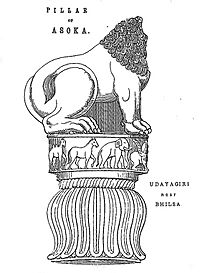
Vidisha is home to many ancient and beautiful sites:
- Bijamaṇḍal: On the edge of the old town are the remains of a huge temple from the 11th century. It was never finished, as you can see from the uncarved parts. A small mosque was later built on top, using some of the temple's pillars. One pillar has an inscription from King Naravarman (around 1094–1134 CE). Nearby, there's a 7th-century step-well with pillars showing scenes of Lord Krishna.
- Lohangi Pir: This is a rock formation named after a saint. It has a small tomb with two old Persian inscriptions from the 15th and 16th centuries. Near the tomb are the remains of an old temple dedicated to Goddess Annapurna.
- Udaygiri Caves: Less than 10 kilometers from Vidisha, these are a group of at least 20 caves. They contain sculptures from the Gupta Era (4th-5th century CE), showing both Hindu and Jain figures. Jain texts say that Tirthankara Sheetal Nath achieved spiritual freedom here.
- Maladevi temple: This grand temple from the 9th century CE is about 40 kilometers from Vidisha. It's built on a huge platform cut into a hillside, offering amazing views of the valley.
- Hindola Torana: This means "swing gate" and is a stunning arched gate from the 9th century. It's made of sandstone and has beautiful carvings of Lord Vishnu's ten forms on its pillars. It might have been an entrance to a temple.
- Bajramath Temple: Located in Gyaraspur, this temple faces east. It was originally a Hindu temple that later became a Jain temple.
- Dashavtar Temple: On the north side of a local lake, you can find the ruins of small Vaishnava shrines. These shrines are dedicated to Lord Vishnu's ten forms, with pillars dating from the 8th to 10th centuries CE.
- Girdhari Temple: This temple in Sironj is famous for its detailed sculptures. Nearby are the ancient shrines of Jatashankar and Mahamaya.
- Udayeshwara Temple: In Udaipur village, this is a very important Hindu temple. Inscriptions here suggest that King Udayaditya built it in the 11th century CE and dedicated it to Lord Shiva.
Vidisha District Museum
The Vidisha District Museum is the main museum in the city. It has many interesting sculptures, clay figures, and coins. Most of these items are from the 9th and 10th centuries CE. You can also find some very old art from the Harrappan period here.
Famous People from Vidisha
- Devi (wife of Ashoka): According to old stories, Emperor Ashoka's first wife, Devi, was the daughter of a merchant from Vedisagiri (which is now Vidisha). Ashoka married her when he was a governor in Ujjain.
- Kailash Satyarthi: Born as Kailash Sharma on January 11, 1954, in the Vidisha district. He is a famous activist who works to protect children's rights and won the Nobel Peace Prize.
Getting Around Vidisha
Vidisha railway station is on a major railway line that connects Delhi to Chennai and Delhi to Mumbai. It is about 54 kilometers from Bhopal. The city is also well-connected by roads, making it easy to travel to and from Vidisha.
Education in Vidisha
Vidisha is known for its good schools and colleges. Many primary and secondary schools follow the Madhya Pradesh Board of Secondary Education. Some schools are also connected to the Central Board of Secondary Education (CBSE).
For higher education, there is the Samrat Ashok Technological Institute (SATI), which is an important college. There is also the Atal Bihari Vajpayee Government Medical College, which started in 2018. Students can get into this medical college by taking the NEET-UG exam.




